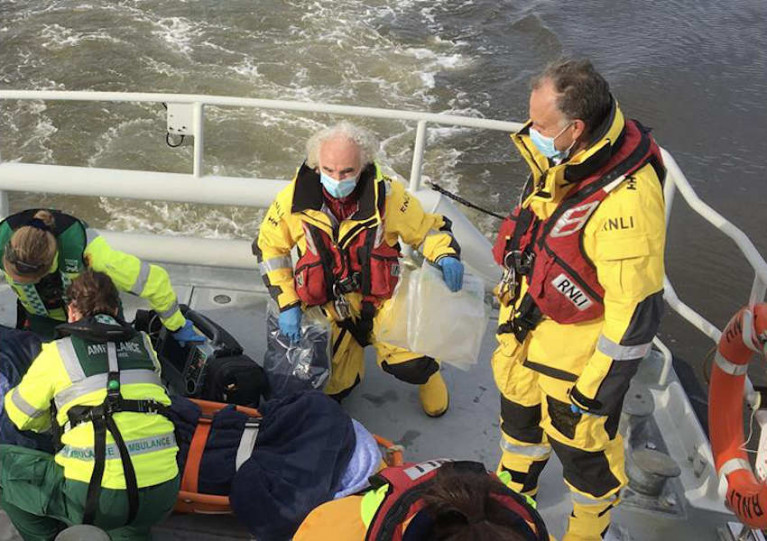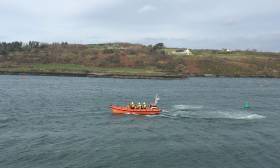Displaying items by tag: Heir island
Baltimore RNLI were called out to a medical emergency on Thursday evening (20 July) to Heir Island off the coast of West Cork.
The volunteer lifeboat crew launched their all-weather lifeboat at 5.06pm following a request from the Irish Coast Guard to provide medical assistance to a woman who had sustained an injury while visiting the island.
Arriving at Heir Island within 15 minutes, coxswain Aidan Bushe requested the immediate launch of the lifeboat’s Y-boat with two volunteer lifeboat crew, Rob O’Leary and Don O’Donovan, on board in order to quickly access the beach where the casualty was.
Due to the nature of the injury, and having spoken to a medical professional who was also assisting on the beach, Bushe felt that a medical evacuation by air was necessary and contacted the Irish Coast Guard to request a helicopter.
A HSE ambulance crew had arrived at the lifeboat station so while the two lifeboat crew remained on the beach, the lifeboat returned to the station in Baltimore, collected the two paramedics plus an additional lifeboat crew member and quickly returned to Heir Island.
The two paramedics were then transferred onto the beach by the Y-boat and care was handed over as they awaited the arrival of the coastguard’s Shannon-based helicopter Rescue 115, who airlifted the casualty to hospital for further treatment.
Conditions during the call-out were relatively calm with a northeasterly Force 2 wind and very little sea swell.
Speaking following the call-out, Kate Callanan, Baltimore RNLI volunteer lifeboat press officer said: “This is a great example of a multi-agency rescue with Baltimore RNLI, the Irish Coast Guard and the National Ambulance Service all working together to assist in this medevac.
“We would like to wish to casualty a speedy recovery. If you find yourself in a medical emergency whilst on an island, call 999 or 112.”
There were six volunteer crew onboard the lifeboat: Coxswain Aidan Bushe, Mechanic Sean McCarthy and crew members Pat Collins, Don O’Donovan, Stuart Musgrave and Rob O’Leary.
Baltimore Lifeboat Launches for Medevac from Heir Island
Baltimore RNLI were called out to provide a medical evacuation this morning (Friday 30 October) from Heir Island off the coast of West Cork.
The volunteer crew launched their all-weather lifeboat at 9.22am following a request from the Irish Coast Guard to provide medical assistance and evacuation to a man living on the island.
Along with two HSE paramedics, the lifeboat crew arrived at Heir Island pier just 10 minutes later and used a stretcher to transfer the casualty from his home to the lifeboat, and then back to the station and the awaiting ambulance.
Conditions at sea during the callout were calm, with a westerly Force 2 wind and no sea swell, ahead of the strong winds expected with Storm Aiden tomorrow, Saturday 31 October.
There were seven volunteer crew onboard the lifeboat: coxswain Kieran Cotter, mechanic Micheal Cottrell and crew members Aidan Bushe, Brendan Cottrell, Ronnie Carthy, Emma Lupton and Jerry Smith.
Baltimore Lifeboat Assists In Medevac From Heir Island
Baltimore RNLI carried out a medical evacuation last night (Wednesday 22 May) from Heir Island off the coast of West Cork.
Baltimore’s volunteer lifeboat crew launched their inshore lifeboat following a request from the Irish Coast Guard at 8.34pm to provide medical assistance and evacuation to a woman on Heir Island who had sustained injuries following a fall.
The inshore lifeboat arrived at the pier on Heir Island at 8.50pm and removed the casualty to the lifeboat station 20 minutes later, where she was handed over to the care of HSE Ambulance crew.
Conditions at sea during the callout were calm with good visibility and no sea swell.
This was the first call for Baltimore’s new Atlantic 85 inshore lifeboat, Rita Daphne Smyth, since she arrived on station last September.
Speaking following the callout, Baltimore RNLI volunteer lifeboat press officer Kate Callanan said: “Baltimore lifeboat is often called upon to safely transport casualties between the islands and mainland, and our volunteer crews are trained in casualty care.
“If you find yourself in need of medical assistance, call 999 or 112 and ask for the coastguard. We wish the casualty a full recovery.”
There were four volunteer crew onboard the lifeboat: helm Jerry Smith and crew members Kieran Collins, Micheal Cottrell and Ian Lynch. Assisting at the boathouse in Baltimore were Rianne Smith, Marty O’Driscoll and Kieran Cotter.
In other lifeboat news, the outgoing chair of Clonallen Bridge Club, Warrenpoint, Maire Murray, chose the RNLI as the charity of choice for the year 2018-19.
At a recent meeting of the Clonallen Bridge Club a cheque for £500 was handed over to John Fisher, Kilkeel RNLI lifeboat operations manager by the club’s incoming president Marius McQue.
Fisher said: “As a charity we are always very thankful for all the money collected and donated to the RNLI. Giving our lifesavers the equipment they need to save lives is very expensive so be assured that the funds raised are used in the best possible way.”
Encouraging Young Sailors Into Keelboats & A 'Cool' Ship In The North Sea
#islandnation – Heir Island, which is mistakenly called 'Hare Island' and in Irish is known as 'Inishodriscol' is one of "Carbery's Hundred Isles," that are "scattered," as some descriptions put it, throughout Roaringwater Bay on the West Cork coastline. It is two-and-a-half kilometres long, with spectacular flora and fauna.
Historically the island formed part of the O'Driscoll clan territory and was known as Inis Ui Drisceoil or Inis an Oidhre. The English version of the name has been traditionally misspelt as "Hare" ---- since 1694 at least, so the islanders claim.
It is also the location of Heir Island Sailing School, a Training Centre approved by the Irish Sailing Association and which for the past two weeks has been training future keelboat sailors amongst a coterie of interested youngsters.
Encouraging young people into sailing is very important for the future of the sport so it is good to hear positive reports about the innovation introduced on Heir Island in to teach young sailors the skills of keelboat racing.
"We can't take credit for the natural environment," John Moore who, with Patricia, runs Heir Island Sailing School, told me. "But what we can do is develop an interest in sailing as an active, enjoyable for sport for everyone and widen the interest of young people in aspects of the sport."
With residential accommodation available at the centre the Irish Cruiser Racing Association which has overseen the running of racing for keelboats, chose it as the base for a new initiative "Keel Boat Race Week." ICRA has the job of bringing together the various aspects of Irish handicap racing. Since its inaugural meeting in 2003 when sailors, primarily from Cork and Dublin, met in Waterford to establish the Association it has built a solid core of interest among cruiser racing enthusiasts. It has also led the successful Irish winning of the top UK international trophy, the Commodore's Cup.
With Heir Island Sailing School the initiative, open to all junior sailors in the country was launched, aimed at Transition Year students in particular, to run two week-long courses for young sailors keen to broaden their sailing and racing experience. The school year schedule for 'Transition' provided the way to do this and those committed to the future of the sport took the opportunity.
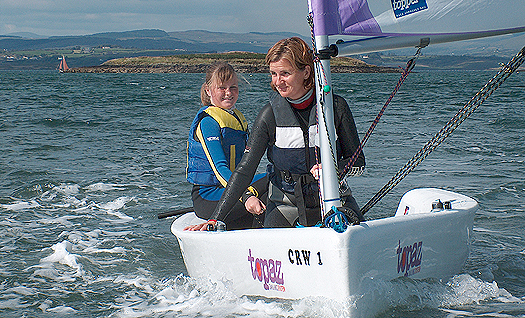
Twenty-five young sailors took part in the first of the two weeks and sixteen were involved on the second week, all keen to broaden their sailing and racing experience. A team of expert coaches, using six, matched, open keelboats taught them to develop skills associated with racing keelboats including handling the mainsail, headsail trim, bow work, helming, tactics and spinnaker handling. Ben Fusco, Head Coach at the Royal St George Yacht Club in Dun Laoghaire, a student yachting world champion, was chosen by ICRA to be involved in this project as well as Ben Lynch, an offshore sailor, who has raced aboard Volvo Open 70s and competed in some of the world's most challenging offshore races.
"At the end of the course they have gained familiarity with the various roles on keel boats as well as an appreciation of the tactics and strategy used throughout keel boat races," John said. The youth sailors came from areas around the coast. "They have also learned how to adapt the dinghy approach, in the boats they would have been sailing up to now, to bigger, more powerful boats".
There is a near-permanent difficulty in getting and keeping crews for cruiser racers, as I know from personal experience, so building up a reservoir of future sailors is important for the sport. One of the biggest problems has been the loss of young sailors after they leave dinghies. Many of them do not to remain in the sport.
Encouraging them to do so and developing the youth interest is important. In this regard Whitesail racing has provided an opportunity for families to race together. At the Friday evening racing in the RCYC in Crosshaven we adopted a youth policy aboard my own boat, a 33ft. Sigma and put our youngest crew member on the helm, a 10-year-old sailor from the Optimist bronze fleet. The training young sailors get in those little boats is impressive.
Conditions were mostly light enough during the three-race series for Oisin, my grandson, to helm our boat with tactical advice from the senior members of the crew. We won the series with a 1st and 2nd in a tie-breaker with the next boat, Micheál Lynch's, Lady T, both finishing on 9 points. Micheál deserves a lot of praise for his commitment to whitesail which has encouraged more people to take their boats out racing and enjoy the experience. It was good to see the way in which the RCYC sailors encouraged our young helm. The future of sailing will depend heavily on those who race for enjoyment. Without them, the highest competitive level of the sport will not have a foundation upon which to develop.
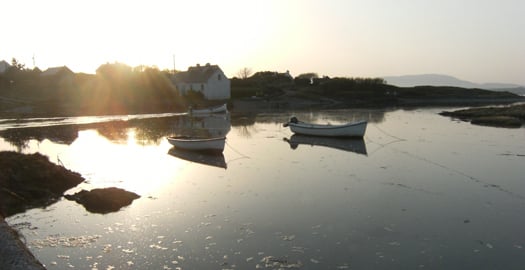
Heir Island
So let's give more encouragement to the youngsters. They will take over eventually, one way or the other (!) But helping them along will benefit the sport – and perhaps more boats and owners! When Oisin took over on the helm I went to where I have been on other boats - sitting on the rail. There is a different perspective there. It didn't lessen my overall concerns, because being owner I still have to sign the cheques when equipment and replacements are needed (!) but I did take a lot of satisfaction from seeing a youngster from the Optimist fleet handle the helm of a 33ft. cruiser effectively and I did learn – that we can all be replaced !
'COOLEST' SHIP IN THE NORTH SEA
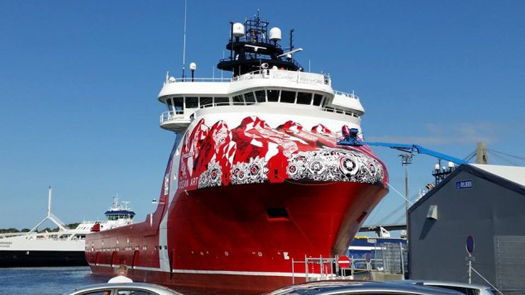
There are not too many ships as brightly painted as the one pictured here, the new vessel launched for the Norwegian offshore supply shipping company Atlantic Offshore, Ocean Art PSV, in Stavanger. It was built at the Kleven shipyard in Myklebust, Norway and named during the ONS offshore energy conference in Stavanger, which coincided with the Nuart street art festival. A Polish street artist, Mariusz "M-City" Waras, painted the ship. It is the second of two VS 485 MKIII L designs ordered by Atlantic Offshore from Kleven and is to go on a six-year contract with Statoil in the North Sea. They claim it is the "coolest looking" ship in the North Sea! It certainly won't be un-noticed.
THE NAVY CALLS BACK!
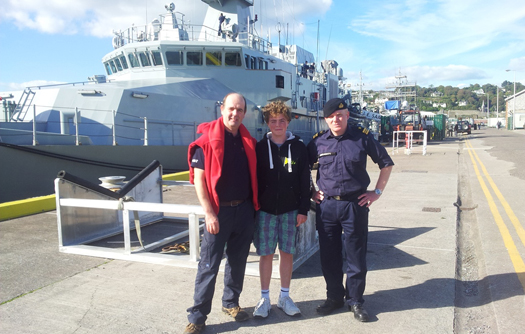
John Hegarty, skipper of odd job at MBSC, his son Morgan and Lt. Cdr. Tony Geraghty, Commander of LE Samuel Beckett at the Naval base
I described, back in July in this blog how I was crewing aboard a yacht out of Monkstown Bay in Cork Harbour in that club's Thursday night cruiser league when the VHF came alive with the first radio call I had heard from the new Naval vessel, 'SAMUEL BECKETT' which had come up astern of us, returning from sea patrol. The Naval voice courteously requested if 'ODD JOB,' the yacht on which I was crewing, would alter course in the 'narrows' as the water area off Cobh and between Haulbowline Island is called by sailors, so that the State warship could make her approach to the Naval Base. Our Skipper, John Hegarty, acknowledged with equal courtesy and called a tack so 'ODD JOB' came about to go astern of 'L.E SAMUEL BECKETT' which then went into her berth at the Base. We brought 'ODD JOB' about again and returned to the racing fray, but the alteration cost us first place on handicap by two minutes and forty seconds. However, this incident showed the value of courtesy and good seamanship. The Navy showed equal courtesy in making contact after they read the story here on the Afloat website. We were invited to visit the ship and were shown over it by her commander, Lt.Cdr.Tony Geraghty. She is an impressive vessel. I recorded an interview with Lt.Cdr. Geraghty which will be transmitted on my THIS ISLAND NATION radio programme and which you can hear next week here on afloat.ie
130 YEARS OF DUBLIN SAILING
As a Southern sailor, I have to admire the sight of all the sails in Dublin Bay out of Dun Laoghaire which I have seen over the past two Saturdays when my journeys took me along the seafront. It was very impressive, a great panorama of the sport and an indication of just how big the marine leisure sector is and its potential importance to the national economy. Congratulations to Dublin Bay Sailing Club which celebrated its 130th Anniversary at the weekend. The club has made a great contribution to the development of sailing since it was founded in 1884 and has co-ordinated racing in and out of Dun Laoghaire harbour. It has also influenced the development of yacht design through classes such as the Dublin Bay 25s, the Dublin Bay 21s, the Dublin Bay Mermaids and the Dublin Bay 24s. When marine correspondent with RTE I saw the efficiency of the DBSC in running sailing events. Long may it continue.
GETTING RID OF A SPY SHIP

November 5 should be an interesting day on the web. Rosatom which is a Russian State Corporation, will be holding an auction for bids to demolish the warship, SSV-33 Ural, that was launched in 1983. Nuclear-powered, it was regarded as a "spy" ship but hadn't a successful career. After less than two years in operation, there was a fire aboard and, with the fall of the USSR, there wasn't enough money for repairs, so she was taken out of service. The ship must be disposed of within the Bay of Bolshoy Kamen in the Primorsky region by November 30, 2017. Nuclear fuel was unloaded from the ship's reactor and removed for recycling in 2009. Parts of the ship are to be used to repair other nuclear-powered Russian naval vessels.
THIS ISLAND NATION EXPANDING
From next week my THIS ISLAND NATION radio programme is moving from monthly to fortnightly transmission. It will be broadcast here on the afloat website, so I hope you will tune in.
Until next week, the usual wish of .....
"fair sailing..."
Email: [email protected]
Twitter: @Tom MacSweeney
The West Cork Islands of Bere, Dursey, Garnish, Heir, Long, Cape Clear, Sherkin and Whiddy are inviting visitors to 'explore the islands, experience island life' in a special island festival in June.
The idea behind the celebration from June 15 and 16 is to encourage visitors to see what life on an island is like. The island communities are saying 'be an islander for the weekend'. Enjoy reduced rates on ferries/cable car activities, services and accommodation. Jump on a ferry or the cable car at islander rates.
More details on the festival are here
Sailing School Navigates Beyond the Gloom
The Principal John Moore has discounted all prices by 20 to 30%. All 2009 sailors returned in 2010 and brought friends with them. The French network of the newly appointed Director of Sailing Hugues Traonmilin has brought French families to the island and the French sailors were mixed with the Irish and British children and adults with great success. In addition to a busy summer season, 60 students of a South East College came for the very first time to the Sailing School in March 2010 as part of the Transition Year programme. They were hosted with full board accommodation at the Sailing School Guest house.
Definitely the location of the Sailing School plays a big part in this success story. Heir Island is located in the middle of Roaring Water Bay half way between Schull and Baltimore. Whatever direction you sail from the Sailing School beach, you'll encounter wonderful maritime landscapes and crystal clear waters. The Topaz dinghy fleet may sail to 3 or 4 different sandy beaches on one sailing day. The 3 Dublin Bay Mermaids sailing in flotilla explore the surrounding islands of Castle Island, Sherkin Island, the 3 Calves Islands and of course the Carthy's Islands to visit the seals colony.
Such a fantastic location has orientated the programme of this Sailing School towards the "Adventure" courses of the Irish Sailing Association. The school offers Adventure 1 & 2 courses as their "speciality" course.
2011 perspectives are already very encouraging with a second college to be hosted in Spring for a 10 day transition programme meanwhile the first one is returning after excellent feedback of the 2010 students and teachers. Being a family run business makes this small company very flexible and the range of their activities covers young sailors from 8 years old to adults, groups and families, on dinghies or on a traditional Heir Island Lobster Boat, and on kayaks if you don't want to sail. Also as a qualified Yachtmaster Instructor, the director of sailing has facilitated individually tailored sail training for yacht owners aboard their own yacht, an option that has proven both practical and successful.
More information HERE.


























